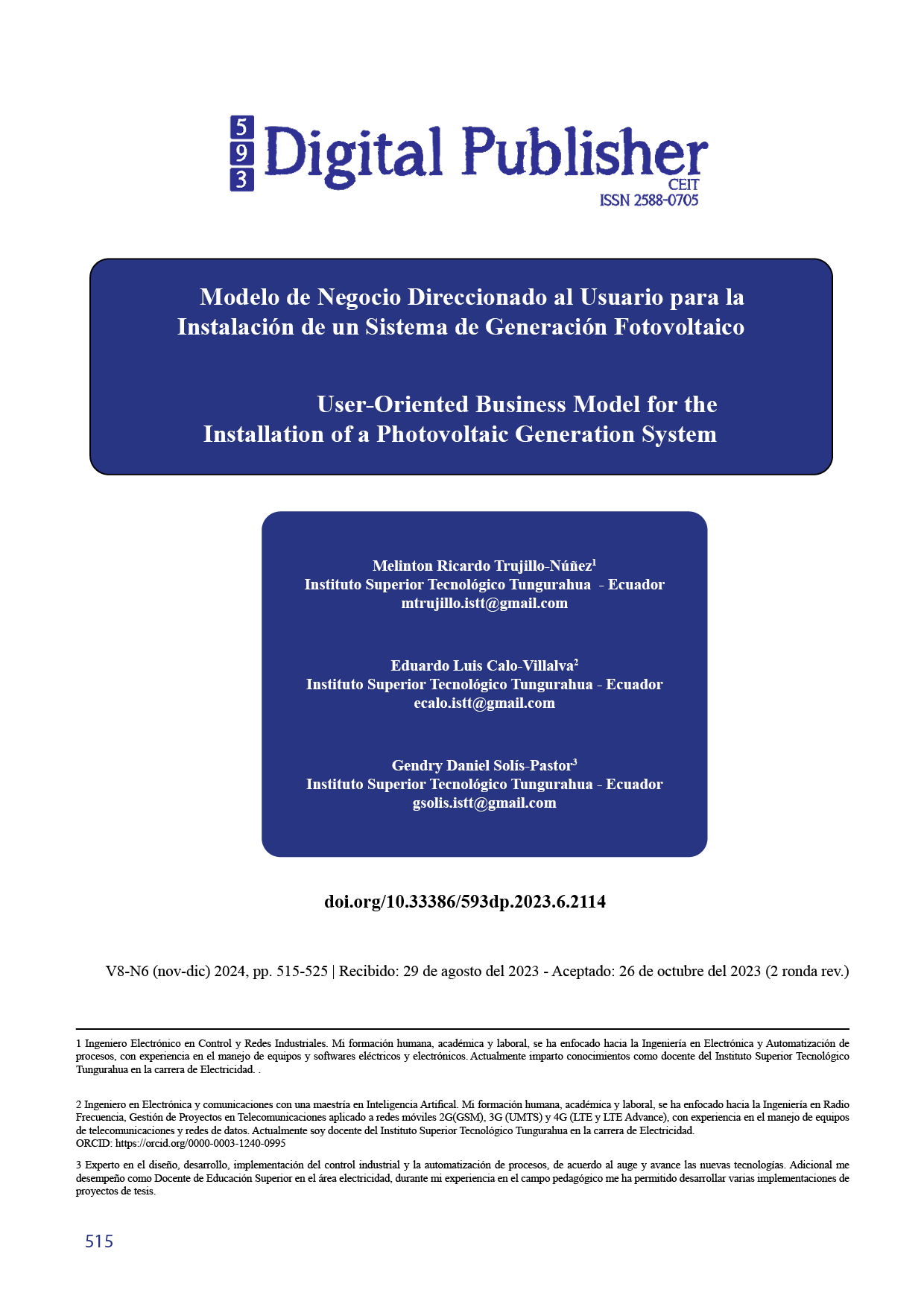User-Oriented Business Model for the Installation of a Photovoltaic Generation System
Main Article Content
Abstract
The study focuses on analyzing the perception of a business model based on the installation of a photovoltaic generation system for the validation of its commercialization in the center of the country. For this, a personalized solar energy solution was exposed that satisfies their energy needs at an affordable price and complying with the existing regulation, business models must adapt to the different changes that allow them to be competitive and also offer an optimal benefit. service that guarantees the development of a sustainable society in the future. A business model seen from the user for the installation of a photovoltaic generation system is beneficial for both users and the environment, likewise the results show a significant increase in the adoption of photovoltaic systems by users, which that supports the effectiveness of the proposed business model. It is concluded that this user-centered approach is crucial to drive the transition towards renewable and sustainable energy sources.
Downloads
Article Details

This work is licensed under a Creative Commons Attribution-NonCommercial-ShareAlike 4.0 International License.
1. Derechos de autor
Las obras que se publican en 593 Digital Publisher CEIT están sujetas a los siguientes términos:
1.1. 593 Digital Publisher CEIT, conserva los derechos patrimoniales (copyright) de las obras publicadas, favorece y permite la reutilización de las mismas bajo la licencia Licencia Creative Commons 4.0 de Reconocimiento-NoComercial-CompartirIgual 4.0, por lo cual se pueden copiar, usar, difundir, transmitir y exponer públicamente, siempre que:
1.1.a. Se cite la autoría y fuente original de su publicación (revista, editorial, URL).
1.1.b. No se usen para fines comerciales u onerosos.
1.1.c. Se mencione la existencia y especificaciones de esta licencia de uso.
References
Abdillah, L., Mukti, Y., Puspita, D., & Suhartini. (2021). Indonesian sharia fintech services and social media usage. Bulletin of Social Informatics Theory and Application, 5(2),97–106. https://pubs.ascee.org/index.php/businta/article/view/456
Abella, M. A. (2005). Sistemas fotovoltaicos. SAPT Publicaciones Técnicas, SL.
Abella, M. A. (2014). Dimensionado de sistemas fotovoltaicos. Centro de Investigaciones Energéticas, Medioambientales y Tecnológicas”. Tesis para optar al titulo de maestrıa, Departamento de Energıas Renovables. Escuela de organización industrial.
Aguilera, J., Hontoria, L., & Muñoz, F. J. (2011). Dimensionado de sistemas fotovoltaicos autónomos. Grupo Idea, Departamento de electrónica, Escuela politécnica superior, Universidad de Jaén.
Arias, H. D. A., Arroyo, L. D., & Cardona, A. J. A. (2016). Evaluación del potencial de generación fotovoltaica en la ciudad de Quibdó, Chocó. Elementos, 6(6), 109-123. GómezRodríguez, M. A.,
Arencibia-Carballo, G. (2016). La importancia del uso de paneles solares en la generación de energía eléctrica. REDVET. Revista Electrónica de Veterinaria, 17(9), 1-4.
Arencibia-Carballo, G. (2016). La importancia del uso de paneles solares en la generación de energía eléctrica. REDVET. Revista Electrónica de Veterinaria, 17(9), 1-4.fotovoltaica (Doctoral dissertation, Universidad Nacional de Mar del Plata. Facultad de Ingeniería; Argentina).
Bresh, E. (29 de Febrero de 2016). El Pensante . Recuperado el 8 de Diciembre de 2016, de Educacion: https://educacion.elpensante.com/e-f-l-bresh-concepto-de-administracion/
Cáceres Pompei, A. R. (2020). Proyecto y diseño de un sistema de generación Arencibia-Carballo, G. (2016). La importancia del uso de paneles solares en la generación de energía eléctrica. REDVET. Revista Electrónica de Veterinaria, 17(9), 1-4.
Cabero; Hernández. (1995). El proceso de análisis de los datos. Infoescuela, 73.
Cauas, D. (5 de 12 de 2012). mecanicahn.com. Obtenido de http://www.mecanicahn.com/personal/marcosmartinez/seminario1/los_pdf/l-Variables.pdf
Espinosa Palomeque, D. V. (2010). “análisis y propuesta de un modelo de gestión de responsabilidad social empresarial caso: empresas ecuatorianas comprometidas con rse” . Quito Ecuador.
Farhat, M., Barambones, Ó., Ramos, J. A., Duran, E., & Andujar, J. M. (2015). Diseño e Implementación de un Sistema de Control estable basado en Lógica Borrosa para optimizar el rendimiento de un sistema de Generación Fotovoltaico. Revista Iberoamericana de Automática e Informática industrial, 12(4), 476-487.
Gómez Sarduy, J. R., Lorenzo Ginori, J. V., Fonte González, R., & García Sánchez, Z. (2021). Pronóstico de la generación eléctrica de sistemas fotovoltaicos. Un inicio en Cuba desde la universidad. Revista Universidad y Sociedad, 13(1), 253-265.
Giraudy Arafet, C. M., Massipe Cano, I., Rodríguez Rivera, R., Rodríguez Gámez, M., & Vázquez Pérez, A. (2014). Factibilidad de instalación de sistemas fotovoltaicos conectados a red. Ingeniería Energética, 35(2), 141-148.
Guasch Murillo, D. (2003). Modelado y análisis de sistemas fotovoltaicos. Universitat Politècnica de Catalunya.
Mateu I Giral, J. (1995). La teoría del desarrollo sostenible y el objeto de la educación ambiental. Interuniversitaria de Formacion del Profesorado n. 23, 53-64.
Mejía, E. (2019). Diseño de un sistema fotovoltaico autónomo para el suministro de energía eléctrica al laboratorio de Ingeniería Mecánica de la Universidad Politécnica Amazónica. Revista Científica Pakamuros, 7(2), 73-88.
Monge Ivars, J. F., & Juan Pérez, Á. A. (2012). Estadística no paramétrica: Prueba Chi-Cuadrado. Recuperado el 7 de Febrero de 2017, de Estadística no Paramétrica: https://www.uoc.edu/in3/emath/docs/Chi_cuadrado.pdf
Naar, R., & Maya, L. (19 de Octubre de 2013). Gestion Administrativa. Recuperado el 6 de Diciembre de 2016, de http://gestionadministrativaugma2013.blogspot.com/
Namakforoosh, M. N. (2005). Metodología de la investigación. Mexico: LIMUSA Noriega Editores.
Núñez, J. R., Benítez, I. F., Proenza, R., Vázquez, L., & Díaz, D. (2020). Metodología de diagnóstico de fallos para sistemas fotovoltaicos de conexión a red. Revista Iberoamericana de Automática e Informática industrial, 17(1), 94-105.
Pesantez, J. P., Ríos Villacorta, A., & Redrován, J. G. (2021). Integración de Sistemas Solares Fotovoltaicos en el Sector Camaronero Intensivo y Extensivo del Ecuador: Caso de Estudio en la Provincia de El Oro. Revista Politécnica, 47(2), 7-16.
Pilco, D., & Jaramillo, J. (2008). Sistemas fotovoltaicos para iluminación: paneles fotovoltaicos. Univ. Técnica Part. Loja, 1-4.
Renzzetti, M. (2008). ¿que es el factor de potencia ? España .
Rodríguez Gámez, M., Vázquez Pérez, A., Castro Fernández, M., & Vilaragut Llanes, M. (2013). Sistemas fotovoltaicos y la ordenación territorial. Ingeniería Energética, 34(3), 247-259.
Sáenz Campos, D., & Tinoco Mora, Z. (1999). Introducción a la investigación científica. Fármacos, 67-71.
Valdiviezo Salas, P. D. (2014). Diseño de un sistema fotovoltaico para el suministro de energia electrica a 15 computadoras portatiles en la PUCP.




